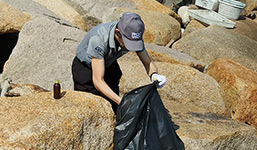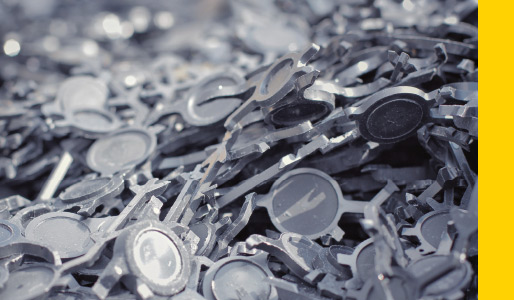Waste and Effluents
Waste & Chemicals
OUR AMBITION
Strive for zero waste in landfill, reduce our consumption of chemicals and eliminate hazardous materials.
2025 GOAL
95%
of our waste reused and recycled
Our waste management programs cover all waste streams generated by our own operations and all related activities and products. We prioritize solutions to reduce, reuse, recycle, and recover rather than dispose, and we align our actions with both local regulations and ST policy, always applying the most stringent requirements. I 103-2 I
2019 performance
In 2019, 94% of the waste generated by our operations was reused, recovered or sent for recycling, and we remain on track to reach our goal of 95% by 2025. We also reduced the waste sent to landfill from 4% in 2018 to 3.4% in 2019, in line with our objective of less than 3%.
Waste split I 306-2 I
Waste hierarchy
Our various manufacturing processes can generate hazardous or potentially hazardous waste such as chemical substances and contaminated plastics. We pay close attention to each type of waste that can impact the environment or people’s health and safety. In 2019, 48% of our waste was identified as hazardous. Most of it (94%) was reused, recovered or sent for recycling. The remaining waste was disposed of and treated locally by specially authorized companies.
The way we treat waste depends on its characteristics and on local capabilities. Our sites adopt different approaches to reduce the amount of waste generated and improve its recycling. At our sites in Calamba (the Philippines), Shenzhen (China) and Crolles (France), an emphasis on greater employee awareness and improved labelling led to better waste sorting and a higher rate of recycling.
94%
of waste reused, recovered, or sent for recycling
Of course, the best waste is the one we do not produce. With this in mind, our Tours site (France) modified two pieces of manufacturing equipment to better segregate water and a specific hazardous substance, reducing the amount of waste sent for incineration by 30 tons per year.
Managing our effluents
Wastewater is treated on-site or externally in dedicated treatment plants, either owned by ST or developed in collaboration with local authorities and partners. These remove polluting substances such as fluoride, which in some cases cannot be treated by municipal plants. Once the wastewater has obtained a sufficient level of purity and any risk of pollution is eliminated, it is discharged into the natural environment. We work closely with local communities to reduce all risks related to water discharge and pollution.
In 2019, our manufacturing sites carried out various initiatives to improve the management and treatment of wastewater. For example, our Crolles site (France) strengthened measures to protect the stormwater infrastructure by adding special valves to load and unload hazardous substances in the storage area.
In addition, our Calamba site (the Philippines) installed a new filter press for filtering wastewater and improving the wastewater recovery process in the treatment plant. This has increased our recycling rate and we estimate that it will reduce water withdrawal by 21% by 2020.
Progressing towards a circular economy
Our sites always look for opportunities to reuse the waste generated to benefit the environment, local communities and ST. We have implemented various initiatives and techniques to achieve this:
- Landfill industrial waste is transformed into solid combustible material and used in cement factory furnaces.
- Sulfuric acids are used for recycling batteries.
- Spent resin and sludge are used in the cement and brick industry.
- Deflashing waste powder is sent for precious metal recovery.
- Electronic waste is dismantled; some parts are reused, and precious metals are recovered.
- Solvents are sent for distillation and reuse.
- Solvents are burned and the energy recovered.
- Ammonia in wastewater is treated and used in agricultural fertilizers.
- Silicon wafer scraps are used for aluminum production.
- Paper, cardboard, plastics and wood are recycled.
- Organic waste is transformed into compost.
Employee initiatives

FOCUS
Participating in clean-up operations
Engaging employees in environmental initiatives is a good opportunity to raise awareness of the need for everyone to be more responsible and to encourage good behavior, both individually and collectively. Every year, our sites organize or take part in initiatives to clean up rivers, beaches, and cities in locations where we operate. In 2019, this included activities in:
- Taipei (Taiwan), where 915kg of rubbish was collected on a beach
- Tokyo (Japan), where volunteers from our sales office cleaned up around Shinagawa train station
- Hong Kong, where 23 ST employees collected 82kg of rubbish on a beach, along with 348 plastic bottles for recycling
- Ang Mo Kio (Singapore), where ST staff participated in a beach clean-up initiative
In addition to this, our Muar site (Malaysia) joined the Melaka Smart River project to monitor the water and air quality in Melaka using our IoT technology.

Romain Fouqueray
Environment Engineer, Tours (France)
Our program to reduce waste by eliminating single-use plastic cups in our offices and canteen was an excellent opportunity to highlight the difference we can all make to safeguard our environment. To remove the need for disposable cups in the ST canteen and at office water fountains, we replaced them with customized ceramic mugs for all employees that can be reused instead of thrown away. This small but significant change was welcomed by staff and very much appreciated. As a result, we decreased the amount of plastic waste generated by almost three tons!”
Going beyond our operations
Stronger control of waste management
When waste leaves our sites, it still needs to be properly treated and disposed of. In line with our internal specifications, local EHS teams visit waste disposal suppliers to assess their compliance with ST’s requirements, local regulations, best practices and treatment techniques. In 2019, 25 audits were performed at our suppliers’ waste disposal facilities, six more than in 2018. For example, at our Ang Mo Kio site (Singapore), a team comprising people from EHS, purchasing and quality, conducts these audits with suppliers, reinforcing collaboration within teams and with suppliers to achieve better waste management.
25
waste disposal suppliers audited
Reducing plastic use in our offices
The need to reduce plastic waste is widely recognized as a global environmental priority. Several ST sites initiated plans in 2019 to eliminate single-use plastic in offices and canteens. Employees at our Paris, Tours (France), Geneva (Switzerland) and Hong Kong sites, were provided with glass bottles, mugs and thermos bottles to replace plastic cups. The Tours site estimated that this will help save 910,000 disposable cups per year, equivalent to 2.8 tons of plastic (see quote).
Contributing to the Sustainable Development Goals
Our commitments and programs related to Waste and Effluents as described above contribute to:
SDG target 3.9 – Substantially reduce the number of deaths and illnesses from hazardous chemicals and air, water and soil pollution, and contamination.
SDG target 6.3 – Improve water quality by reducing pollution, eliminating dumping and minimizing release of hazardous chemicals and materials, halving the proportion of untreated wastewater and substantially increasing recycling and safe reuse globally.
SDG target 12.4 – Achieve the environmentally sound management of chemicals and all wastes throughout their lifecycle, in accordance with agreed international frameworks, and significantly reduce their release to air, water and soil in order to minimize their adverse impacts on human health and the environment.
2019 OBJECTIVES |
Status |
Comments |
|
≤3% waste in landfill. |
|
3.4% |


